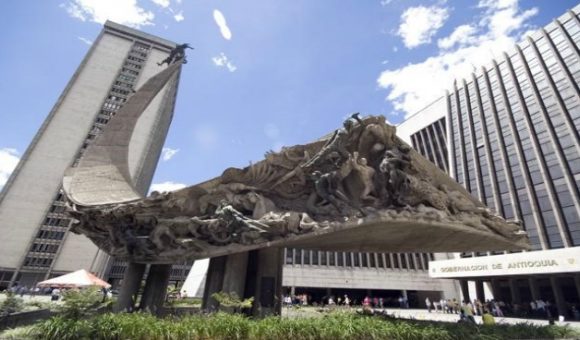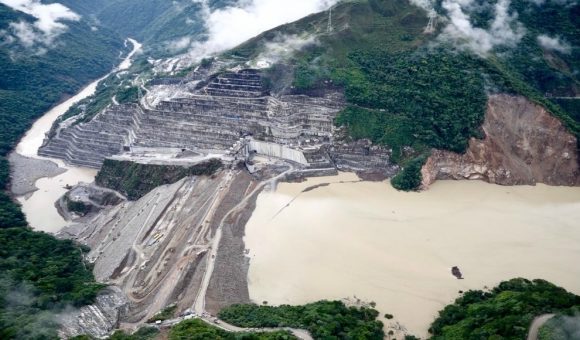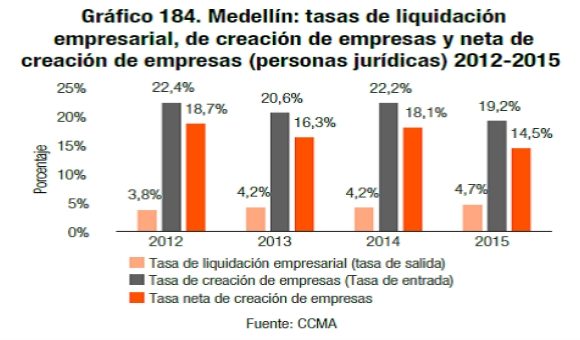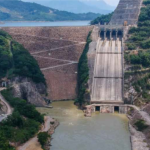EPM Shuts Last Water Tunnel to Hidroituango Hydroelectric Dam

Medellin-based multinational electric power giant EPM announced Tuesday, February 5, that it successfully shut the last water-intake tunnel at its giant Hidroituango hydroelectric dam, hence accelerating the planned diversion of the Cauca River over the dam’s engineered spillway by several weeks – and also enabling repairs to begin.
Temporarily, the decision means that downstream fish populations will be affected for about three days — because the Cauca River still requires three more days to rise to the level of the engineered spillway at the top of the dam.
In a press conference, EPM general manager Jorge Londoño de la Cuesta explained that technical experts advised EPM to accelerate the closure of the water-intake tunnels in order to avoid a possible collapse of those tunnels.
Rising pressure differences between the water behind the dam and the water entering the tunnels would increase with rising water levels, threatening a potential tunnel collapse, the experts warned. Such a possible collapse would have prevented EPM from controlling water levels through the machine room, potentially wrecking the US$5 billion project and possibly endangering downstream populations.
As the last intake-gate was shut to the water tunnel, downstream water flows below the dam started falling drastically – to an estimated 35 cubic meters per second, down from around 450 cubic meters per second in recent days.
But flows should return to “summer-season” normal by next weekend (February 8-9) when the dam spillway outflow gradually restores normal Cauca River levels in the downstream area, he explained.
To reduce temporary impact on fish, EPM hired and trained 700 local fishermen to help rescue fish trapped in pools as water flow diminishes, he added.
In addition, EPM released extra water from its Porce hydroelectric dam system near Guatape, Antioquia, in order to boost river flows where the Nechi River meets the Cauca River at the town of Nechi, Antioquia, downstream from Hidroituango.
Cauca River flows have been decreasing in recent weeks because of the typically low-rainfall “summer season” of February and March. That decline in flow prompted EPM to hire local people to help rescue some 32,000 fish recently trapped in pools downstream of the dam.
Now that the final water-intake gate at the dam is closed, EPM personnel can start the process of entering the machine room, which has been flooded since last May because of an unexpected collapse in a nearby diversion tunnel. Since the dam and the spillway weren’t yet finished last year, EPM made an emergency decision to divert Cauca River water through the machine room, in order to avoid a dam collapse.
Since then, EPM and its engineering partners discovered a big hole that had opened between water-intake tunnels one and two, which lead to the machine room. The hole probably developed because of water erosion — caused by the emergency evacuation of river water through the machine-room tunnels, according to EPM.
Now, EPM not only will have to repair damages to the machine room, but also to the water-intake tunnels damaged by erosion over the past 10 months.
The company still hopes to start-up the 2.4-gigawatt Hidroituango project by year-end 2021, which eventually would supply fully 17% of Colombia’s entire national electricity demand.
But EPM can’t be certain of the start-up schedule until it has the opportunity to inspect the damages in the machine room and the tunnels.
The city of Medellin gets nearly 25% of its entire annual budget from city-owned EPM. So, restoration and recovery of the Hidroituango project will be crucial to city finances in the coming decades.
















